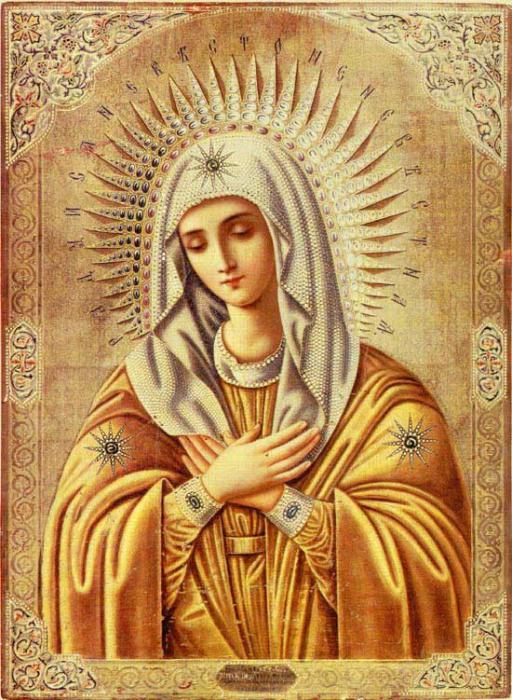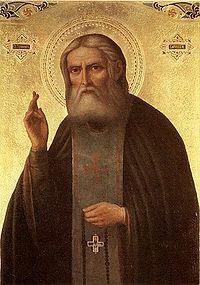
Orthodox tradition differs from other traditionsChristian faiths with their developed and very profound iconography. Not the last role, and perhaps even the first, in it is the image of Mary, the Mother of Jesus Christ. It is connected both with the folk veneration of this woman, and with the theological attention to it of the church doctrine.
The first images of the Mother of God are known from aboutthird or fourth century. Precisely to say it is difficult, as various researchers challenge the dating of the most ancient of the known images of Mary. However, in the official doctrine its status was fixed not earlier than the fifth century. More precisely - in 431 in the city of Ephesus. There, at the meeting of Christian bishops, the title of the Mother of God was formalized behind her. Since then, her iconography began to develop rapidly.
It is important to understand that the icon of Mary, the mother of Christ, is notsimply depicts a holy woman. It represents precisely the spiritual component of the person who has become the mother of God, as Christians believe in it. Therefore, in the Orthodox tradition, it is always considered in the light of Jesus, the divine messiah.
There are a lot of different imagesOur Lady. Previously, for every city and every monastery, and often just for a significant temple, it was considered a good idea to have your own unique icon, marked either by miraculous healings or by other Grace of God, such as mirotochenie. Therefore, today in the calendar there is no such day, which would not have been dedicated to at least one icon of Mary. More often than not, there are several such images a day.
One and a half thousand years of the development of the tradition have developed several basic so-called canonical types of the image of the Virgin. One of them is called "Eleusa", which is the subject of this article.

This word from the Greek language can be translated as"Merciful, compassionate, merciful." But in Russia the term "affection" is most often used. It is not a wrong translation, just accentuates other aspects of spiritual relationships between people and the one whom believers call the Heavenly Queen.
A distinctive feature of this type isthe position of the baby in the hands of Mary. The Virgin "Affection" touches her cheek with the cheek of Christ. Thus, in the icon by artistic means, the idea of unlimited love between God taking upon himself human nature and people who ascended to the divine level (which is represented by the figure of the Mother of God) is embodied by artistic means.
In the Greek tradition, this iconographic typealso called glycophilus, which literally means "sweetly loving." In any case, "affection" is a graphic representation of the idea of love, which was revealed in the sacrifice of Jesus Christ. This is the manifestation of the mercy of God. And in folk piety, far from the theological intentions of church painting, the meaning of affection became associated with the tender relationship of the baby and Mary, which is absent from other types of iconography, where Christ is represented as power-ridden and powerful by the king sitting on the hands of Mary as on the throne. A vivid example of Aleus is the image of Vladimir the Virgin.

But in addition to the general notation of the iconographictype, "affection" - this is also the name of a specific image. Strangely enough, this icon (as well as its varieties) refers to another type of image, called Agiosoritissa. Therefore, it is worth to say a few words about it separately.
The name of this type comes from the chapel of the saintraki (agia soros) in Constantinople. Mary, according to this tradition, is depicted without Christ in a turn of three quarters. Her hands are folded in a prayerful gesture. The view can be either raised up or down. Of the icons of this type, there is one particularly venerated image, called "affection". Its significance for the Orthodox is difficult to overestimate, since it is firmly connected with the great shrine - the Diveevsky monastery and its founder, St. Seraphim of Sarov. And this name is probably associated with a special emotional impression, which he makes on the person contemplating him. The fact is that this image of "affection" is an example of the painting of Western writing, that is, unlike the Orthodox canonical iconography, it emphasizes the purely human features in the personality of Mary - the mother, the afflicted woman, the praying intercessor, etc.

Icon of the Mother of God "Tenderness" from Diveevois famous for being a cell-like image of the Monk Seraphim of Sarov - an extremely revered Russian saint in the Orthodox Church. If we believe in church legends, then Mary personally appeared in the visible image several times. During the prayer before this icon he died.

Because of the great popular love for SeraphimSarov and the cult around it Diveevskaya icon "Tenderness" is a huge historical and cultural value, not to mention its ecclesiastical importance. Today, this image is kept in the patriarchal residence in Moscow and once a year, on the Feast of the Praise of the Mother of God, is exhibited for universal worship. The Icon of the Mother of God "Tenderness" differs in its print copies in huge editions. In the church world, this is a kind of spiritual trend of the last two decades. Since it also has a lot of handwritten lists, revered in various parts of Russia and abroad.


























